DNA relationship testing confirms whether genetic links exist between alleged relatives. This type of test can be performed between various relatives including siblings, grandparents and their grandchildren or aunts and uncles with their nephews or neices.
Why do a DNA relationship test?
Generally, people might opt to do such a test as a means of establishing paternity in cases where the father is not available and therefore, a straightforward father-child paternity test is not an option. In such cases a grandparentage test or an avuncular DNA test can substitute a paternity DNA test. Siblings may also do a sibling DNA test, which will indicate the type of sibling relationship: half siblings, full siblings or unrelated.
Sibling:

Determine whether you are half or full biological siblings or not related at all. A known parent is always recommended to be included when possible.
READ MORE
Aunt/Uncle:

An aunt/uncle test can substitute a DNA paternity test. This test is carried out between alleged father’s siblings and the alleged father’s child/children to confirm the biological relationship between them.
READ MORE
Grandparent:

Confirms if a biological relation exists between Grandparents and Grandchild. Commonly used when the Alleged Father is not available for testing.
READ MORE
Maternity:

This test will prove the biological relationship between mother and child. Maternity testing is often used for immigration testing and sometimes in cases of adoption.
READ MORE
Y test:

Y-STR Male Lineage DNA test is used to determine if two males share the same paternal lineage.
READ MORE
Twin:

The test will establish if twins are identical or fraternal. The test is performed via oral swab samples collected at home.
READ MORE
MtDNA:

MtDNA test based on the mitochondrial DNA sequence variation that is passed on from females to their offspring. Through this test we can determine if two or more people are related through their maternal lineage
READ MORE
 CUSTOMER SERVICE AWARD WINNER
CUSTOMER SERVICE AWARD WINNER







 01227 502982
01227 502982